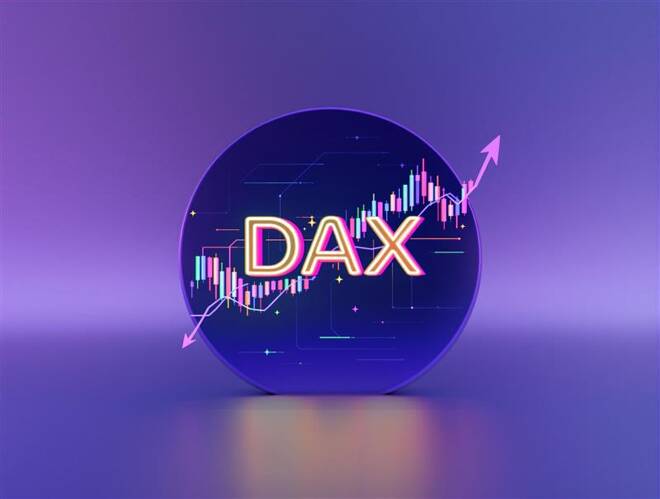Advertisement
Advertisement
Dax Index News: Early China Meeting Hints Lift Risk Sentiment—Forecast Turns Bullish
By:
Key Points:
- Fresenius and Continental gains help cushion losses on May 6, as investors shift focus to earnings and data releases.
- China trade meeting fuel DAX futures rebound, with optimism returning in early trading on Wednesday, May 7.
- Wednesday’s German factory order forecast at +1.3% could offer insight into pre-tariff demand as the Fed rate decision looms.
DAX Ends Nine-Day Winning Streak
The DAX snapped a nine-day winning streak on Tuesday, May 6, falling 0.41% to 23,250 in a choppy session. The nine-day rally had brought the DAX within reach of its all-time high of 23,476 before hitting the reverse.
The DAX fell to a session low of 22,861 after Merz initially failed to secure enough votes. However, a second vote later in the day led to a rebound after Merz’s election as Chancellor.
Adding to the negative mood, President Trump warned of potential tariffs on pharmaceutical products.
Earnings Cushion the Blow of Tariff Worries
Fresenius Medical Care rallied 5.19%, while Continental AG gained 2.40% after posting strong earnings estimates.
Auto stocks had a mixed session amid tariff uncertainties. Porsche and Mercedes-Benz Group gained 0.58% and 0.35%, respectively. In contrast, Volkswagen and BMW posted losses of 0.66% and 0.21%.
Meanwhile, the threat of tariffs on pharmaceutical goods weighed on the healthcare sector. Siemens Healthineers fell 1.23%.
Corporate earnings will be in focus on Wednesday, May 7. Siemens Healthineers, BMW, and Vonovia are among the big names to release earnings results.
German Factory Orders Take the Spotlight
The German economy will be in the spotlight on Wednesday, May 7. Economists forecast factory orders to increase 1.3% in March after flatlining in February. However, the front-loading of orders in anticipation of Liberation Day may skew the numbers, limiting their impact on sentiment. April’s report will likely offer a clearer insight into the effects of US tariffs on demand.
Meanwhile, political developments will remain key, with attention turning to Chancellor Merz’s fiscal plans.
Wall Street Falls Amid Trade and Rate Concerns
US markets extended losses on May 6 as the absence of trade deals raised fears of a hawkish Fed stance to tame tariff-fueled inflationary pressures. The Nasdaq Composite Index and the S&P 500 fell 0.87% and 0.77%, respectively, while the Dow dropped 0.95%.
US trade data took a back seat, with trade developments and sentiment toward the upcoming Fed rate decision and press conference dictating market trends.
Fed in Focus
In today’s US session, the spotlight turns to the Fed. While economists widely expect the Fed to stand pat, uncertainty lingers about the Fed’s policy outlook.
Risk assets, including the DAX, could face volatility if Powell signals a near-term policy hold to assess the influence of tariffs on inflation. A hawkish stance could raise tensions with President Trump, who has previously threatened to remove Powell. Conversely, support for rate cuts to bolster the US economy may trigger a DAX rally.
DAX Outlook: Trade, Data, and Central Banks in the Driver’s Seat
The DAX’s trajectory remains hinged on trade updates, key economic releases, and the FOMC press conference.
- Bullish Case: Resumed US-China trade talks, upbeat economic data, and a dovish Fed stance could send the DAX above 23,476.
- Bearish Case: Escalating US-China trade tensions, US recession fears, or a hawkish Fed could drag the DAX toward 22,500.
As of Wednesday morning, the DAX futures rose 32 points, while the Nasdaq 100 mini jumped 124 points, indicating a positive start to the session.
Reports of US Treasury Secretary Scott Bessent’s planned meeting with China’s lead economic official fueled early optimism.
Technical Setup: Cautious Optimism
Despite Tuesday’s decline, the DAX remains above the 50-day and the 200-day Exponential Moving Averages (EMA), pointing to underlying bullish momentum.
- Upside Target: A break above 23,350 could open the path to the record high of 23,476. A decisive move through 23,476 may bring 23,750 into view.
- Downside risk: A drop below 23,000 could enable the bears to target 22,750. If selling pressure intensifies, 22,500 would be the next key support level.
The 14-day Relative Strength Index (RSI) at 65.17 suggests the DAX has room to climb to the record high of 23,476 before entering overbought territory (RSI > 70).
Conclusion: Monitor Macro Themes and Trade News
DAX traders should remain alert to trade developments, Fed Chair Powell’s commentary, ECB signals, and earnings results—all of which may influence short-term market direction.
Click here to explore our latest DAX research, macro insights, and emerging market coverage.
About the Author
Bob Masonauthor
With over 28 years of experience in the financial industry, Bob has worked with various global rating agencies and multinational banks. Currently he is covering currencies, commodities, alternative asset classes and global equities, focusing mostly on European and Asian markets.
Advertisement
